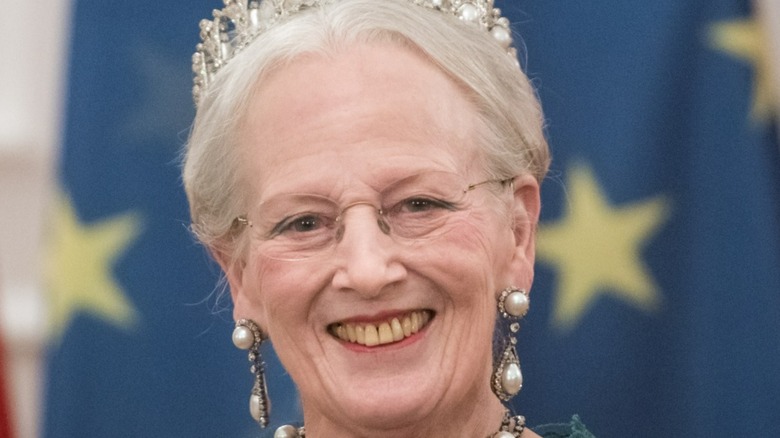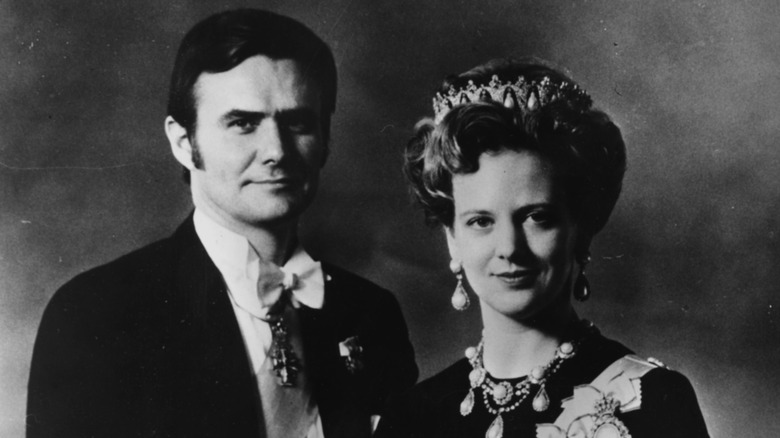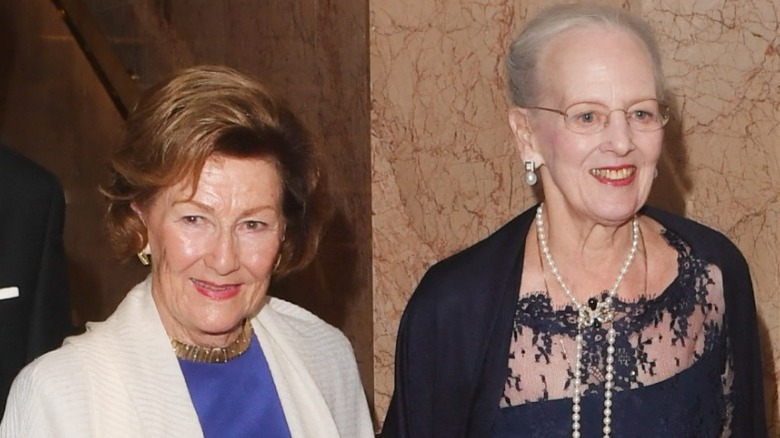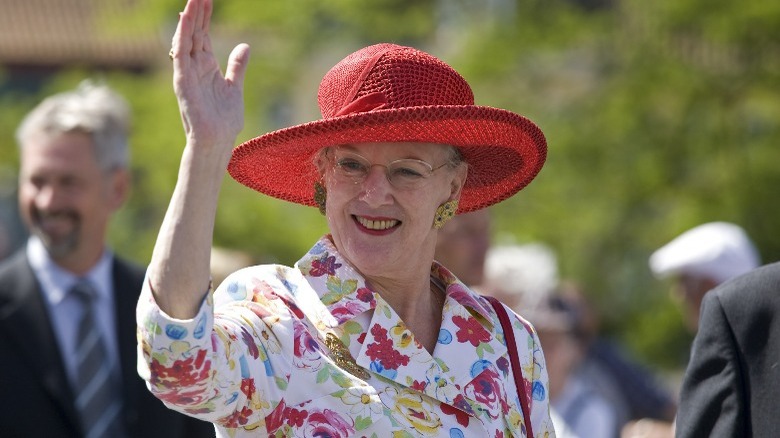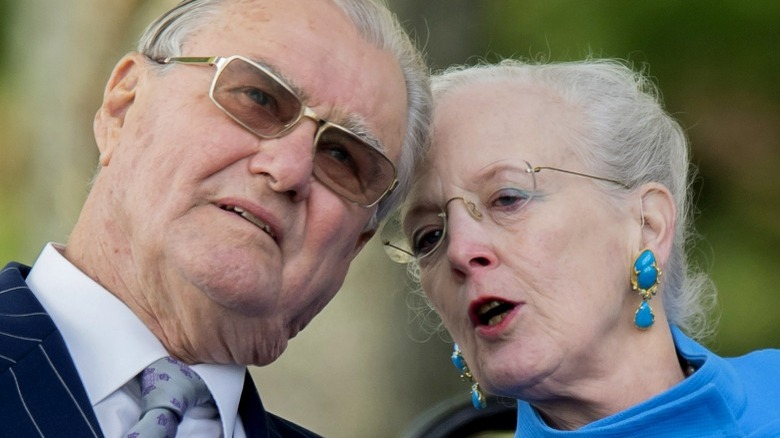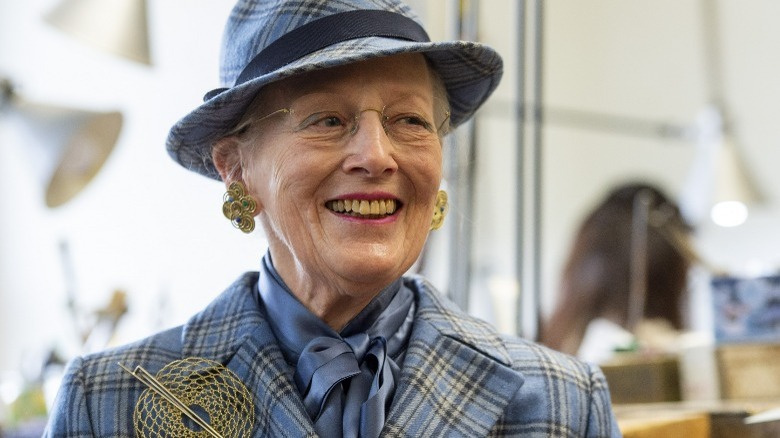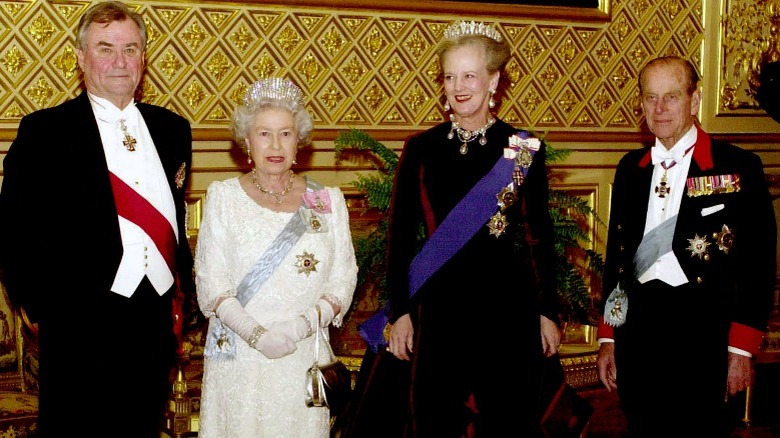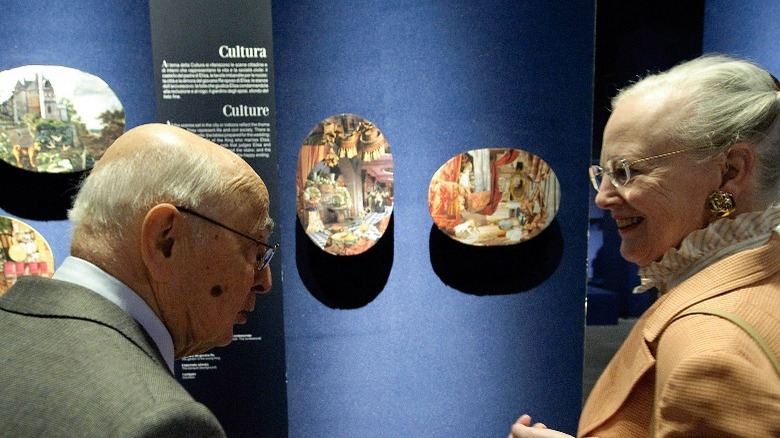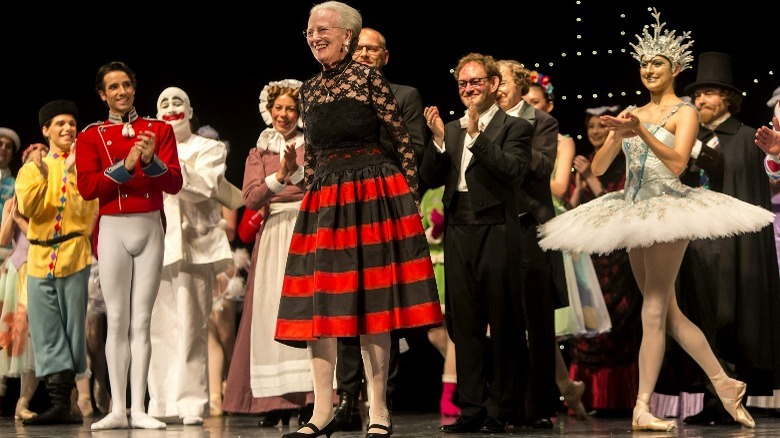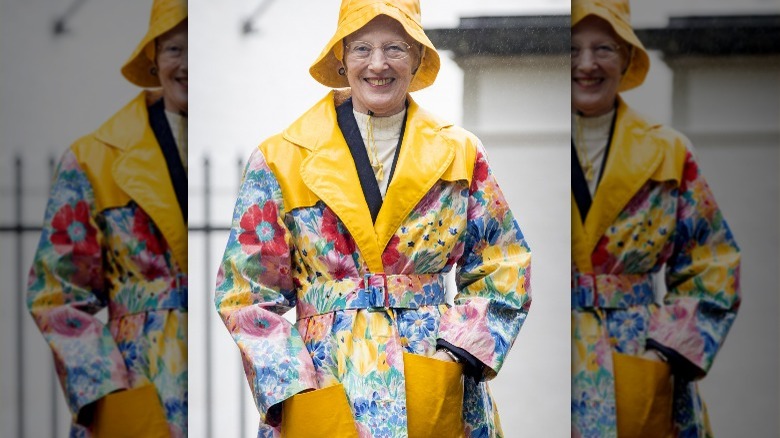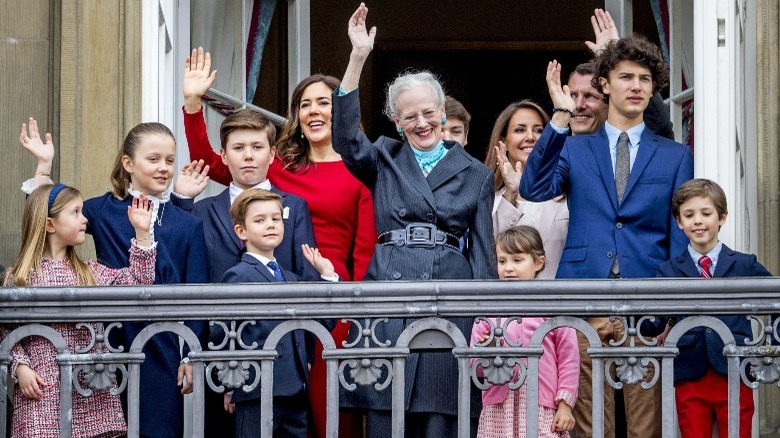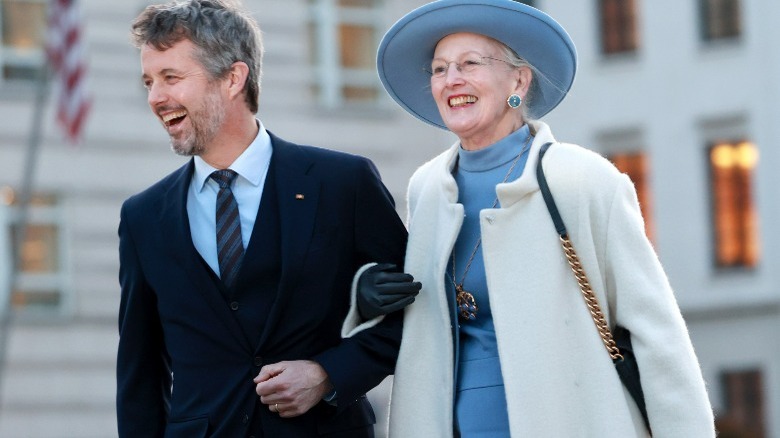Who Is Queen Margrethe Of Denmark?
On September 28, 2022, Queen Margrethe II of Denmark announced that she would be stripping the royal titles of the four children of her youngest son, Prince Joachim. As per the official announcement, her grandchildren will no longer be addressed as princes and princesses, but rather as excellencies, starting from January 2023. The news came as a shock to even Prince Joachim, who told Danish tabloid Ekstra Bladet that his mother's decision was "unfortunate" and that he had only found out about it five days before the announcement (via NBC News).
The familial rift put the spotlight on one of the world's oldest democracies, as well as the popular and accomplished queen who has ruled it with little controversy during her 50-year reign. After Queen Elizabeth's death, she became the only female monarch in the world and Europe's longest-serving current head of state (per The Independent). Here are some things to know about her as the drama with her son and grandchildren plays out in the media.
Queen Margrethe named herself Margrethe II when she took the throne
Before Queen Margrethe turned 13, the Danish constitutional law made it impossible for her to ascend to the throne as a female. However, with the passing of the Act of Succession in 1953, women were allowed the right of succession, but only secondarily (per Denmark's official website). When her father, King Frederik IX, died in 1972, she became Queen of Denmark, as she was his eldest heir and only had two younger sisters.
According to Life Magazine, when she had been officially proclaimed Queen Margrethe by Prime Minister Jens Otto Krag, one of her first decisions was to only be Queen of Denmark and not take on additional royal titles like her predecessors did. In addition, she also declared herself to be Margrethe II in honor of Denmark's first queen from the late 14th century, who would henceforth be known as Margrethe I. During Margrethe I's reign, she actually never was officially named queen and was called "lady and husband" of Denmark, so Margrethe II was the first to be officially acknowledged as Queen of Denmark from the start of her reign.
She is highly educated and speaks five languages fluently
According to the Danish Royal Family website, the queen studied philosophy at Copenhagen University and earned a diploma in prehistoric archaeology from the University of Cambridge in England. She also studied political science at schools across Europe: Aarhus University in Denmark, the Sorbonne in Paris, and the London School of Economics in the U.K. Her interest in archaeology was nurtured by her late grandfather, who took her on excavation trips to Italy in the late 1950s when she was a princess (per Denmark's official website).
Queen Margrethe speaks five languages fluently: Danish, Swedish, French, German, and English. She is a strong proponent of using Scandinavian languages when Nordic people are meeting with each other, and for her efforts, she was presented with the Nordic Association's yearly language award by Queen Sonja of Norway on September 27, 2022 (per the Daily Mail).
The queen even dabbled in literary translation when she translated Simone de Beavoir's "Tous les Hommes Sont Mortels" ("All Men Are Mortal") from French to Danish with the help of her French-born husband, Prince Henrik. The translation was published under a pseudonym in 1981, according to UPI Archives.
The queen's smoking was accused of setting a bad example for Danish women
The queen is a long-time smoker and is known to smoke at least three packs of cigarettes a day. She once admitted at a press conference, "I smoke wherever there's an ashtray" via ABC News. This habit was how she got the nickname "Ashtray Queen" from a Swedish newspaper, and in 2001, a Belgian professor named Hugo Kesteloot actually published a paper in a medical journal that blamed the queen for the increasing mortality rate amongst Danish women (per The Telegraph).
Kesteloot claimed that after two decades of a decline in the mortality rates amongst Danish women, it started to increase again in 1978, which was six years after Queen Margrethe took the throne. By 1996, the mortality rate amongst Danish women was nearly 50% higher than average compared to the rest of Europe. As the queen would often appear in public with a cigarette — something that she no longer does — the professor said in the paper, "As a role model for women, the queen's example could offer an explanation for the unusual mortality in Danish women" (via The Telegraph).
Queen Margrethe dismissed the claims as a "sensationalist way to publish what most of us already know: that many Danish women smoke." Prince Henrik also defended her, saying, "Let people die from smoking if they want. It's their business," and pointed out how the queen's mother smoked and lived until age 90. On Kesteloot's end, he found the royal couple's downplaying to be "rather unexpected and emotional and not very rational" (per ABC News).
Her late husband Prince Henrik held grudges about not being called king
When Henri Marie Jean André de Laborde de Monpezat married Princess Margrethe in 1967, he became Prince Henrik of Denmark and was later given the title of Prince Consort in 2005 (per The Telegraph). The latter was to appease the prince after he allegedly threw a tantrum when the crown prince was chosen over him to represent the queen at a 2002 New Year's ceremony. "For many years I have been Denmark's number two," Henrik said at the time (per the BBC). "I've been satisfied with that role, but I don't want to be relegated to number three."
In 2008, Queen Margrethe decreed that "her sons, their spouses and their descendants [would have] the titles of count and countess of Monpezat," (per the Danish Royal Family website) which is in reference to her husband and are the titles that Prince Joachim's children will get to keep. Despite all this, Prince Henrik remained bitter until the very end when he renounced the prince consort title upon his retirement from royal duties in 2016 and publicly declared that he did not want to be buried next to his wife. "If she wants to bury me with her, she must make me a king consort," he told Danish magazine Se og Hør (via People). "She's the one playing me for a fool." Per the BBC, he was cremated when he died in 2018 with half of his ashes spread over Danish waters and the other half buried at Fredensborg Castle's garden.
Queen Margrethe is not afraid to reprimand Danish citizens like a 'stern mother'
In 2020, Queen Margrethe became the first monarch to address the COVID-19 pandemic on television. "Sadly, not everyone is taking this seriously," she said in her address (via British Vogue). "Some are still hosting celebrations and birthday gatherings. This is not acceptable behavior. It is thoughtless, and first and foremost inconsiderate."
The queen's public straightforwardness is not new to the Danes, as more than half the population tunes in every year for her annual New Year's Eve speech. Queen Margrethe has called out xenophobia and solipsism, for example, and addresses topics like climate change and discrimination against people with disabilities like in her 2021 speech. Danish historian Lars Hovbakke Sorensen says that her speeches are not formal like those of other monarchs, but a way for her to give out "advice to Danes on how to live their lives" (per The Telegraph).
London-based, Danish-born designer Julie Brøgger echoed the same thoughts to British Vogue about the queen's pandemic speech. "She was like a stern mother telling the Danish people to stay at home," she said. "Like many of her New Year's speeches, she isn't afraid of telling people off a bit. It only adds to her popularity and respect."
She scaled back her Golden Jubilee celebrations out of respect for Queen Elizabeth
2022 marked Queen Margrethe's Golden Jubilee, which celebrated 50 years since she had ascended to the Danish throne. While the celebrations had already been cut back due to the pandemic, Queen Elizabeth II's death two days before the celebrations were to start prompted her to make further amendments. As per the announcement on the Danish Royal Family website, she canceled the changing of the guard parade and the royal family greeting on the balcony and also postponed a celebration at the Copenhagen City Hall.
While done out of respect for her fellow head of state, Queen Elizabeth and Queen Margrethe were also close friends and third cousins who affectionately called each other by their nicknames — Lilibet and Daisy, respectively (per Vogue Australia). Prior to attending Queen Elizabeth's funeral with Crown Prince Frederik, she wrote a personal letter to King Charles III, calling his mother "a towering figure among the European monarchs and a great inspiration to us all. We shall miss her terribly."
On September 11, 2022, Queen Margrethe held a gala at the Royal Theater with 1,200 guests including the heads of Norway, Greece, and Finland to celebrate her Golden Jubilee. Before she and her guests enjoyed a show of ballet, plays, opera, musicals, and classical music and a dinner at the Christiansborg Palace, Queen Margrethe held a moment of silence in honor of Queen Elizabeth (per People).
The queen has illustrated Danish editions of The Lord of the Rings
Along with her royal duties, Queen Margrethe has also pursued her artistic and intellectual interests. "Had she not been Queen of Denmark, she would have been an excellent artist, archaeologist, or poet," says Gitte Redder, co-author of "Royal Denmark." "She is considered our 'intellectual Queen' with a lot of talents and vision" (per The Telegraph).
The queen has illustrated a collection of Prince Henrik's poetry, entitled "Cantabile," and her paintings have been displayed in some of Denmark's most popular museums including the National Gallery of Denmark and the ARoS Aarhus Art Museum (per Denmark's official website). To commemorate her 40th anniversary as queen, the Arken Museum of Modern Art held "The Essence of Color: The Art of Queen Margrethe II" exhibition, which displayed 135 of her decoupages and landscape and bone paintings in acrylic and watercolor. "It is an enormous satisfaction to be doing something that you really like doing, and it is also a way of recharging my batteries," she told Reuters.
In probably the most fascinating story about her artistic career, when the queen was a princess studying in England, she sent her interpretations of scenes from "The Lord of the Rings" to J.R.R. Tolkien under the pseudonym Ingahild Grathmer. When the author passed away in 1973, the drawings of Ingahild Grathmer were found with compliments that Tolkein had written. In 1977, 2001, and 2021, the queen's illustrations were published in the Danish version of the bestseller (per Denmark's official website).
She works as a set and costume designer and is working on a Netflix film
Queen Margrethe has worked as a set designer, costume designer, or both for eight productions by the Tivoli Ballet Theatre in "The Nutcracker," "Cinderella," and tales by Danish author, Hans Christian Andersen (per Denmark's official website). Even though she is the queen, she says that doesn't make her above criticism. "I know that when I have an idea that doesn't work people will tell me," she said to reporters during a 2007 rehearsal for "The Tinder Box" (via the Australian Broadcasting Company). "And that is how it should be, since our goal is to create a performance that works, that entertains and pleases the audience and which will be a success for the theatre."
The queen is also an honorary member of the Association of Danish Scenographers for her work as a set designer in Danish film, television and theater. One of her upcoming projects as set designer is a Netflix film called "Ehrengard," which is based on Danish author Karen Blixen's work with the same title. Academy Award and two-time Palme d'Or-winning director, Bille August, shared with Netflix, "The Queen has created the most fantastic decoupages for the occasion, and they will be the dominant feature of the film's overall scenographic expression." In regards to her involvement, Queen Margrethe expressed, "Karen Blixen's stories have always fascinated me, with their aesthetic tales, their imagination and their, to me, image-creating worlds — and I'm very happy to be part of this project."
Queen Margrethe's love for color is shown in bishop's capes and her own clothes
The Queen of Denmark is also an avid embroiderer, and she has designed and also done some of the actual embroidering on bishops' capes and altar cloths for various churches in Denmark, Greenland, Germany, and England (per the Danish Royal Family website). A private collection of hundreds of her embroidery — which included cushions, chair seats, and table cloths that the queen uses at her home and has given as gifts to family, friends, and staff — was on display at the Koldinghus Castle in an exhibition called "The Queen's Embroideries" from April 24, 2021 to January 2, 2022. Queen Margrethe described the color scheme that she uses in her designs as "boisterous."
The same description could also apply to the queen's fashion. "Royals are often partial to color, but Queen Margrethe's take on royal style is very bold," fashion designer Julie Brøgger told British Vogue. "Because she's an artist, she has a totally different understanding of color." One of the queen's most famous self-designed outfits was a raincoat that she outfitted from a flowery, waxy outdoor tablecloth. According to British Vogue, she thought it would brighten up the rainy summer days.
She is credited with modernizing the Danish royal family
Another reason for the queen's popularity is that while she respects the royal traditions that she grew up with, she has also made efforts to modernize the royal family. Both her sons married commoners — Crown Princess Mary was a real estate agent in Australia, while Princess Marie worked in advertising. While Queen Margrethe and her sons went to private schools, her grandchildren have so far been educated at state schools (per The Telegraph).
Over the past decade, the queen has also given more live television interviews, and for state visits, she participates in press conferences herself. Karin Palshøjm, co-author of "Royal Denmark," revealed to The Telegraph that when talking with ministers of foreign affairs, "they all state that their presence [at the press conferences] is not needed: the Queen knows exactly what to say and where the limit goes, and she has a great knowledge of international affairs."
As for the role of the monarchy in a modern, changing society, Queen Margrethe believes that it still has a place. "It has continued to develop. And I am sure it will continue to do so," she said in an interview with the Luxembourg Times during her 40th anniversary. "I cannot provide the recipe — and if I could it would be more worrying. This is something that has to develop and grow naturally."
Queen Margrethe believes that she is 'future-proofing' the monarchy
While Queen Margrethe had stated back then that she did have all the answers about the future of monarchy, her actions in stripping her grandchildren's titles show that she sees its role as being smaller in the future. In light of the strong reactions toward her decision, she released another statement on October 3rd that apologized to her family, but insisted that this was something that she had thought about for a long time. "Holding a royal title involves a number of commitments and duties that, in the future, will lie with fewer members of the royal family," the statement on the Danish Royal Family website read. She called it a "necessary future-proofing of the monarchy."
The fewer members that she is referring to are Crown Prince Frederik and his descendants, who will retain their titles of princes and princesses. When it's time for Frederik to ascend the throne, Queen Margrethe is certain he will be "up to the job" and likened him to her father. "Among others[,] being able to talk to all sorts of people. Down to earth — without any problems and without having to exert himself," she told the Luxembourg Times of her son. "He has an innate community with people — and they with him."
However, she has no intentions to abdicate and Denmark has had no such tradition. The Telegraph reports that Queen Margrethe once said "I will stay on the throne until I drop" and that she is in great health. In May 2022, she even rode a rollercoaster at Copenhagan's Tivoli amusement park at age 82.
